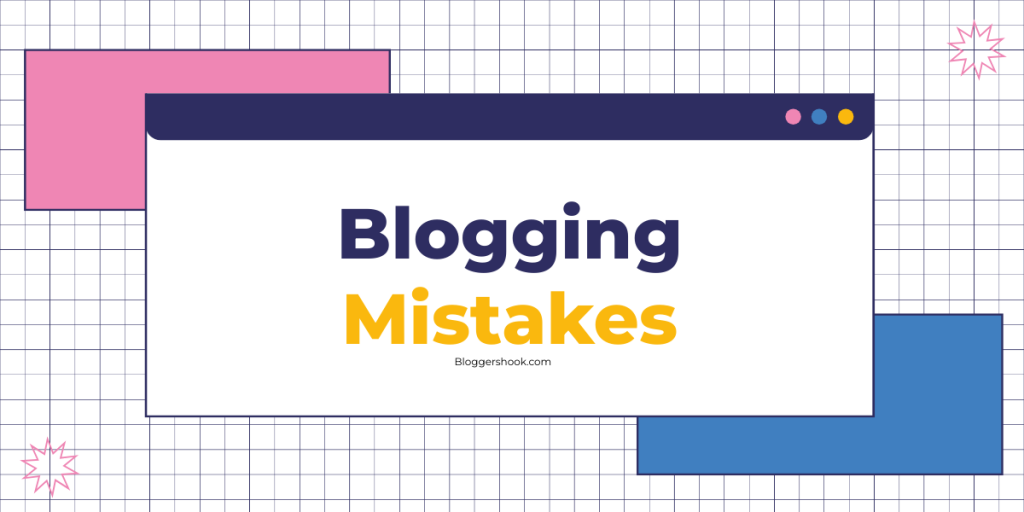Blogging can be an incredibly rewarding activity, whether you are doing it for personal enjoyment, to build a brand, or to earn an income. However, many bloggers—especially beginners—often make common mistakes that can limit their success. Identifying and correcting these mistakes early can help you build a more effective and engaging blog. In this article, we will discuss the 10 most common blogging mistakes and how to avoid them.

1. Not Defining Your Target Audience
One of the biggest mistakes new bloggers make is not defining their target audience. Without a clear understanding of who you’re writing for, your content will lack focus and fail to resonate with the readers who matter most.
How to Avoid This:
- Research Your Audience: Understand the demographics, interests, and needs of your audience. Use tools like Google Analytics and social media insights to gather data.
- Create Personas: Develop reader personas that represent your ideal readers. This will help you tailor your content to their needs.
- Write Specifically for Your Audience: Ensure that every piece of content you produce speaks directly to the problems, questions, or interests of your target audience.
2. Inconsistent Posting Schedule
Consistency is crucial when it comes to blogging. Many bloggers start off strong but eventually fall off due to other commitments or burnout. Inconsistent posting not only makes your blog appear inactive but also causes your audience to lose interest.
How to Avoid This:
- Create a Content Calendar: Plan your blog posts in advance by creating a schedule that outlines when you’ll publish new content. This will help you stay organized and committed.
- Batch Create Content: Write multiple posts when you have time, so you have a backlog of content ready to go. This will help keep your blog active even during busy periods.
- Start Small: If you’re new to blogging, start by posting once a week, then increase frequency as you become more comfortable.
3. Neglecting SEO
Search Engine Optimization (SEO) is critical for driving traffic to your blog, but many bloggers either ignore SEO or don’t fully understand how it works. Neglecting SEO can make it difficult for readers to find your content, limiting your blog’s growth.
How to Avoid This:
- Use SEO Tools: Tools like Yoast SEO, SEMrush, or Ahrefs can help you optimize your blog posts for search engines.
- Focus on Keywords: Do keyword research to find relevant keywords for your blog posts. Use them naturally within your content, titles, meta descriptions, and headers.
- Optimize for Mobile: Make sure your blog is mobile-friendly, as search engines prioritize mobile-optimized sites.

4. Writing for Yourself, Not Your Audience
It’s easy to get caught up in writing content that interests you without considering what your audience wants or needs. While personal passion is important, failing to cater to your audience can lead to low engagement.
How to Avoid This:
- Balance Your Interests with Audience Needs: Find a middle ground between what you want to write about and what your audience is interested in. Use polls or surveys to ask your readers what they’d like to see more of.
- Analyze Comments and Feedback: Pay attention to reader comments, emails, and feedback. This can offer insight into the type of content your audience finds valuable.
5. Poor Content Quality
In the fast-paced world of blogging, it’s tempting to rush through posts just to hit deadlines. However, poor content—whether it’s poorly written, unresearched, or full of grammatical errors—will damage your blog’s credibility.
How to Avoid This:
- Focus on Quality Over Quantity: It’s better to publish fewer, high-quality posts than to churn out low-quality content. Take the time to thoroughly research, write, and edit each post.
- Proofread and Edit: Always proofread your work before publishing. Use tools like Grammarly or Hemingway Editor to check for grammar and readability issues.
- Add Value: Make sure your content provides real value to your readers. Include actionable tips, data, and well-researched information to support your claims.
6. Ignoring Visual Elements
A blog post that is text-heavy can quickly become monotonous. Ignoring visual elements like images, infographics, or videos can make your blog less engaging and harder to read.
How to Avoid This:
- Use High-Quality Images: Incorporate relevant and high-quality images into your posts to break up text and make the content more engaging.
- Create Custom Graphics: Use tools like Canva to create infographics or custom images that help explain complex topics visually.
- Embed Videos: Where appropriate, embed videos that complement your blog content. This can increase engagement and offer an alternative format for readers to consume information.
7. Failing to Promote Your Content
Many bloggers focus entirely on creating content and overlook the importance of promoting it. Simply publishing a blog post isn’t enough—without proper promotion, your content will remain largely unseen.
How to Avoid This:
- Share on Social Media: Use platforms like Facebook, Twitter, LinkedIn, and Instagram to promote your blog posts. Tailor each post to the platform’s specific audience and format.
- Leverage Email Marketing: Build an email list and send newsletters to notify your subscribers when you publish new content.
- Engage in Guest Blogging: Write guest posts on other blogs in your niche. This helps you build backlinks and introduces your content to new audiences.
8. Not Building an Email List
One of the most common blogging mistakes is not focusing on building an email list early on. Email marketing is a powerful tool for nurturing a loyal audience and driving traffic to your blog, yet many bloggers overlook its importance.
How to Avoid This:
- Start Early: Begin collecting email addresses as soon as possible. Even if your audience is small, it’s better to start building your list early.
- Offer an Incentive: Create a lead magnet (like an e-book or free checklist) to encourage visitors to sign up for your email list.
- Use Pop-Ups and Sign-Up Forms: Make it easy for visitors to subscribe by including sign-up forms on your blog and using pop-ups to capture emails.
9. Not Engaging with Your Readers
Blogging isn’t a one-way street. Failing to engage with your readers can create a disconnect between you and your audience, reducing reader loyalty and engagement.
How to Avoid This:
- Respond to Comments: Take the time to respond to reader comments on your blog posts. This encourages further discussion and shows that you value your audience’s input.
- Engage on Social Media: Interact with your readers on social media platforms by responding to their messages, comments, or tweets.
- Ask Questions: Encourage engagement by asking your readers questions at the end of your blog posts. This invites them to share their opinions or experiences, fostering community.
10. Lack of Monetization Strategy
Many bloggers make the mistake of not thinking about how they will monetize their blogs until much later. While building traffic and engagement should be the first priority, having a long-term plan for monetization is important for bloggers aiming to generate income.
How to Avoid This:
- Plan Your Monetization Strategy Early: Think about different ways to monetize your blog early on. Options include display ads, affiliate marketing, sponsored posts, and selling products or services.
- Diversify Your Income Sources: Don’t rely on just one form of monetization. Experiment with different methods to see what works best for your blog.
- Focus on Building Traffic First: Successful monetization depends on having a steady stream of traffic. Focus on growing your audience before fully implementing a monetization strategy.
Over To You
In conclusion, blogging can be a fulfilling and profitable venture, but it requires careful planning and attention to detail. By avoiding these common blogging mistakes, you’ll be better equipped to create a successful and sustainable blog that attracts readers, fosters engagement, and achieves your goals. Whether you’re a beginner or a seasoned blogger, regularly reviewing your blog’s performance and making adjustments will keep you on the path to success.


